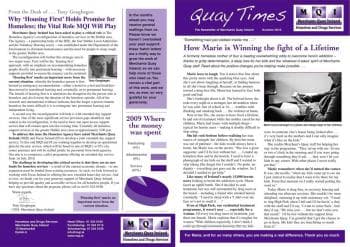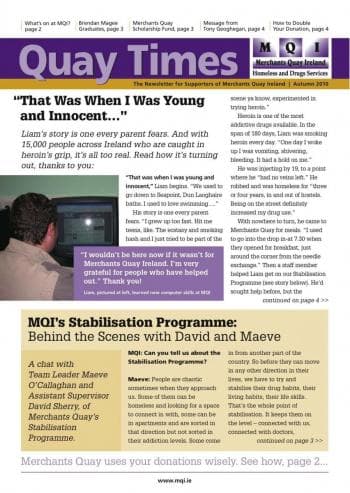Copywriting and design strategies for better donor newsletters: a before and after success story
Fundraising copywriter Lisa Sargent and designer Sandie Collette, of S.Collette Design, discuss how copywriting and design go hand-in-hand to make a Dublin-based charity’s newsletter overhaul a success. Discover the strategies that helped make it happen in this case study of a nonprofit newsletter.
- Written by
- Lisa Sargent
- Added
- March 25, 2011
Let’s begin with results
Shortly after my design colleague Sandie and I finished an overhaul of Merchants Quay Ireland’s donor newsletter, I received an email from MQI’s head of fundraising that read:
‘My phone has been ringing all morning with people telling me how much they like the newsletter and giving me money. It just hit the doormats yesterday.’
Four weeks later, the donations from that newsletter stand at €16,000. Even better, those revenues will soon double – the result of a matching gift on all Christmas donations up to €50,000 (a challenge you can bet we featured prominently in the newsletter).
The ROI for this newsletter after creative, printing and mailing costs is 3:1.
Thirteen copywriting and design strategies that helped make this overhaul of a donor newsletter successful.
Note: the ‘before’ version of the newsletter is MQI's summer issue; the ‘after’ version is the autumn issue, post-overhaul. By clicking on the images, you can open each of the before and after samples in a new window. This will allow you to read the strategies below while simultaneously looking at the PDF samples of the newsletters.
1. Choose your colours
One of the first things to consider is the colour scheme. You’ll save on costs with two-colour printing, but, if you can manage it, four-colour is a much nicer look. (The ‘after’ version of MQI’s newsletter is four-colour.)
In considering colours for sidebars and mastheads, strive for harmonious colours that are also consistent with the ‘feel’ you want to establish. In the samples, you’ll see that MQI’s chief colour is purple and, while this dictated the main accent colour, Sandie chose a different complementary colour to warm things up – in this case, gold.
2. Consider the masthead
Here is where you see a big difference between the before and after versions. The already-established newsletter name, Quay Times, was very difficult to read in the before version. So Sandie strived to give the name a more dominant presence – and we knew she’d been successful when donors began referring to the newsletter by name.
In fact, just by glancing at the thumbnail images on the left, you can clearly see a difference in the before and after mastheads and the ease with which the title of the newsletter is legible.
3. Add a table of contents
One of your jobs, in any multi-page communication, is guiding readers to the next page… and the next. A table of contents helps accomplish this. In this case, it’s straight up at the top in the masthead, which saves space and lets people easily see what’s inside without making a big deal out of it. It also gives scanners and skimmers a bite-sized summary.
4. Select a proper font and type size
There is an emerging trend in print newsletters to go with a sanserif font. But we still adhere to the old rules of readability: always use a serif font for print. You can use sanserif sparingly, but for body copy, we stick with serif; the one we use in the after version is among the most readable. As to type size, Sandie used 11 pt on 13, which means an 11 point type size with 13-point leading (the space between the lines).
Side note: beware of reversed-out text. This is fine to use (again sparingly) when there’s enough contrast and not a lot of copy, as you’ll see on the cover page of the after version; reversed-out text is notoriously hard to read in long stretches
5. Always use photos
In smaller and mid-sized nonprofit organisations, it can sometimes be a challenge to get good quality, high-resolution photos. But MQI faces a different problem: they work with people who are homeless and have addiction problems so many of the women and men they help wish to remain anonymous. For this reason there are not many full-face photos, which of course are best of all, because the eyes engage the reader.
Even so, we opted to give readers even a sideways glimpse of the real people they are helping, as opposed to a stock photo of complete strangers; it's much more authentic that way.
6. Guide the reader
As we noted in the section on contents above, one of the main jobs of any multi-page communication is to guide the reader through from page-to-page. But you also have to guide the reader through each article – and at the same time write for skimmers and scanners, who will never read your newsletter in its entirety.
This means:
- Headlines need to tell party of the story rather than just being cute or funny
- The introduction beneath the headline needs to tell a little more of the story.
- Use subheadings in the body copy that help to tell the full story.
- Continuation lines (jump heads)– these should appear where an article continues onto another page and will need to include a piece of the original headline to help orient the reader.
Note: In the after version, Sandie uses design to clearly differentiate between the headline, intro and body copy. And if there are call-outs, they stand out too.
7. Thank the reader and show off their accomplishments
Wherever possible, without getting too saccharine like, we say thank you. Our goal here is to show the reader, through stories, testimonials, profiles and more, all the amazing things their donations are making possible... this, after all, is the reason you’re writing.
One of the ways we accomplish this is by using a thank-you message as a built-in design element at the top of both the inside spread and page four (back cover).
8. Break up the copy
With any newsletter, we plan for a mix of full-length articles and shorter snippets of information – bullet points, quotes, call-out boxes with bits and pieces of news and shaded areas. This, again, helps skimmers and scanners get what they need and also adds visual interest. (You’ll notice a big difference here between the before and after versions.)
9. Don’t be afraid of numbers
You’ll notice a pie chart on page two – we always include some form of graphic that shows how a donor’s money is being used wisely. And don’t be afraid to sprinkle numbers in elsewhere – in the form of statistics and percentages, for example – just be sure you explain them clearly and always link it to the donor’s role in all of it.
10. Include inside information
It’s a hard and fast rule not to bury your readers in jargon. But I don’t think you need to ‘dumb everything down’ either – in fact, there are certain cases where including jargon or technical terms can make the reader feel like an insider.
In addition to copywriting for the after version, I also did some of the copywriting for MQI’s before version (which is the summer issue of their newsletter). Look at page three of that issue, ‘A day in the life of a Merchants Quay nurse’; in paragraph three, Nurse Steven Doyle talks about chronic leg ulcerations. When editing his wonderful article, I simply defined the term for the reader and shared why it was a problem, then double-checked with him to be sure it was accurate. This is one way to handle technical terms.
11. Feature offers and deadlines
On page four of the ‘after’ version, you’ll see that the €50,000 matching gift is featured prominently along with the 31 December deadline. This creates urgency and excitement... and also primes the reader for opening the direct mail piece when it arrives (yes it’s rudimentary but technically it is still multi-channel fundraising).
12. Call attention to your website
On the inside spread (pages two and three) of the after version, you’ll see two areas where we refer to MQI’s website – this in addition to the URL in the footer. On page three, it is under the photo caption. On page two it's in the ‘what’s on?’ panel.
13. Strike a balance
Nonprofit organisations need to tread carefully when it comes to the overall appearance of their donor communications: not too homespun (you’re professionals, after all) but not too glitzy either. Sandie sums it up, saying ‘you don’t want the piece to look too fancy, because then a donor is thinking that they must’ve paid someone big bucks to do this. And that leads them to think that you’re not making wise use of their donations. My philosophy is not to overdo it’.
© Lisa Sargent and Sandie Collette, 2011



















